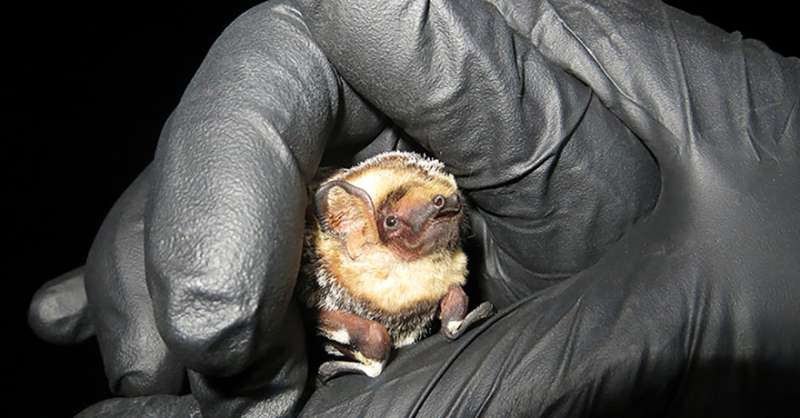Caught 'napping': First direct evidence of migratory hoary bats hibernating

Perched among the branches and needles of California's redwood forests are nestled wayfaring hoary bats (Lasiurus cinereus). A migratory species capable of traveling hundreds of miles, hoary bats may wander throughout western North America before settling into California's north coast...to sleep.
While it's not unusual for some species of bat to migrate or other species to hibernate, it is unusual to find a species of bat that does both. Hoary bats are one of North America's largest bats at 5 inches in length and also one of the continent's most distinguished with its frosted fur for which it takes its name.
Researchers with the U.S. Forest Service's Pacific Southwest Research Station have documented the first recorded evidence of hoary bats going into a state of torpor, or hibernation. Published earlier this month in Scientific Reports and just in time for National Bat Week, Oct. 24-31, "First Direct Evidence of Long-distance Seasonal Movements and Hibernation in a Migratory Bat" reports newly discovered behaviors in hoary bats.
"It's commonly assumed that species that migrate do so to reach areas that allow them to continue feeding and remain somewhat active throughout the winter," said lead author Ted Weller, an ecologist with the Forest Service. "But our findings surprised even our own research team by showing that hoary bats spend much of the winter in hibernation."
In September 2014, Weller and his colleagues tagged several bats within Humboldt Redwoods State Park with GPS tracking devices and another group of bats with a device that monitored light levels, body temperatures and activity, which allowed them to understand how bats responded to varying weather conditions.
"While such tracking and monitoring technology has existed for a while, it hasn't been until somewhat recently that these units were made small enough to be affixed to animals of this size," Weller said.
A month later, two of the GPS-equipped bats were recaptured and their data downloaded. One of the bats met the expected behavior of "site fidelity," with its longest single-day trek being about 4 miles from the initial capture site. The second bat was surprising in that it had produced multiple single-day treks ranging from 30 to 45 miles. However, it was the third bat recaptured several months later that produced the most intriguing behavior.
For the month of October, Bat VHF5 flew more than 600 miles, making a loop into southern Oregon, then into interior California, then over to the Nevada-California border, and then back again into interior California.
"It's hard to determine what led to such a journey," Weller said. "Was he seeking favorable temperatures and humidity for roosting and foraging? Was he trying to intercept females to mate with as they migrated to their wintering grounds?"
The monitoring devices attached to the other group of bats also offered new insights into the species. Two bats from that group were recaptured in spring, with one of the bat's devices having captured 224 days of data. Based on lowered body temperatures and inactivity, that bat exhibited the signs of being in a torpor state from November 2014 through April 2015, including a 40-day stretch without flying.
Which again leads researchers to the question: Why would a species capable of migrating hibernate? The answer could lie within the bats' roosting habitat.
"Hoary bats roost outside in trees as opposed to inside caves," Weller said. "It's possible that hoary bats are evolved to hibernate, but would freeze if they did so in their northern summer territories."
The Redwoods, in particular, are ideal in that they offer an environment with lots of shelter, cool temperatures and plenty of moisture to reduce the risk of dehydration.
Similar to other migratory species, understanding seasonal movements and wintering habits are essential for conservation efforts. And because most bat research is confined to summer when bats are most active, these findings are especially useful.
"This research has provided us with a valuable look into the lives of hoary bats rarely before seen, and until now, never before documented to this extent," Weller said. "Knowing more about their lives outside of the summer months will help us better understand what steps might best promote their conservation."
More information: Theodore J. Weller et al, First Direct Evidence of Long-distance Seasonal Movements and Hibernation in a Migratory Bat, Scientific Reports (2016). DOI: 10.1038/srep34585
Journal information: Scientific Reports
Provided by USDA Forest Service
















